Inclusive Philosophy: Child Development & Family Engagement
VerifiedAdded on 2023/06/11
|7
|1196
|270
Essay
AI Summary
This essay discusses the importance of inclusion in early childhood education and care, focusing on child development and working with families. It emphasizes the Ontario government's Renewed Early Years and Child Care Policy Framework and the Canadian Charter of Right and Freedom. Key aspects of inclusion, such as policies promoting inclusion, supportive staff, and leadership, are highlighted, along with the principles of welcoming disabled children, ensuring equal access to play and learn, active participation in decision-making, community respect for differences, timely access to information, and proactive removal of barriers. The essay also underscores the role of families as activists and partners in supporting children's learning, advocating for their involvement in school governance, and addressing the diverse needs of learners through collaboration and a learner-friendly environment. The conclusion reiterates the family's pivotal role in a child's life and the importance of family participation for the success of inclusive programs. Desklib offers a variety of study tools and solved assignments to aid students in their educational journey.
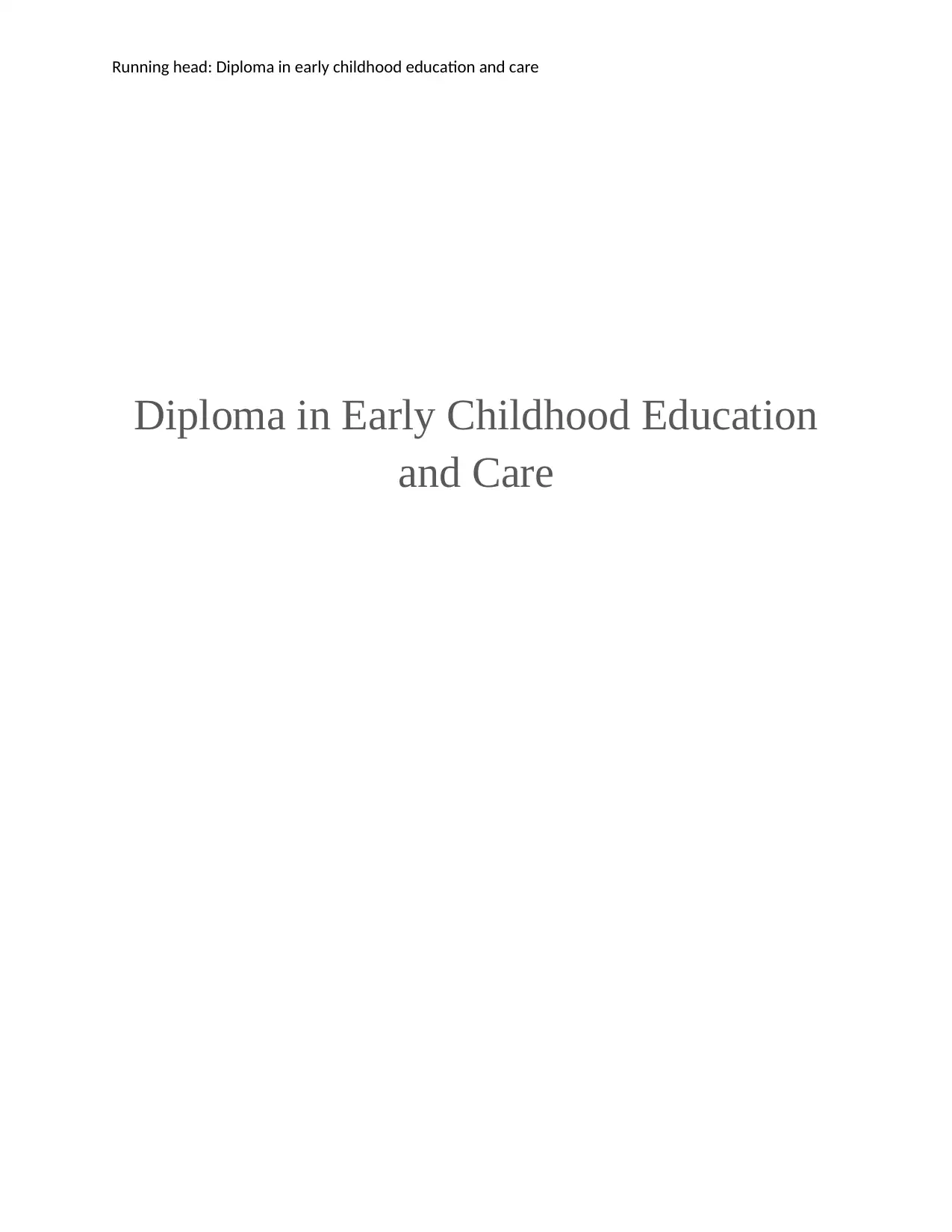
Running head: Diploma in early childhood education and care
Diploma in Early Childhood Education
and Care
Diploma in Early Childhood Education
and Care
Paraphrase This Document
Need a fresh take? Get an instant paraphrase of this document with our AI Paraphraser

Contents
Overview of the course material..................................................................................................................3
Child development......................................................................................................................................3
3 key features of inclusion.......................................................................................................................3
6 principles of inclusion..........................................................................................................................4
Working with families.................................................................................................................................4
3 key features of inclusion.......................................................................................................................4
6 principles of inclusion..........................................................................................................................5
Conclusion...................................................................................................................................................6
References...................................................................................................................................................7
Overview of the course material..................................................................................................................3
Child development......................................................................................................................................3
3 key features of inclusion.......................................................................................................................3
6 principles of inclusion..........................................................................................................................4
Working with families.................................................................................................................................4
3 key features of inclusion.......................................................................................................................4
6 principles of inclusion..........................................................................................................................5
Conclusion...................................................................................................................................................6
References...................................................................................................................................................7

Overview of the course material
The government of Ontario has formulated a framework known as Renewed Early Years and
Child Care Policy Framework which evaluates the plan to change the childcare system of the
province. The program has been formulated under the Canadian Charter of Right and Freedom
which is a federal law providing that each individual is equal before the law without being
discriminated due to physical and mental disability as per section 15 of the Equality Rights. The
Human Rights Code of Ontario is a law which provides the right to be equally treated in the
context of accessibility of services which being discriminated on the grounds of disability
(Macaulay Child Development Centre, 2014). So, in this article, the various aspects of inclusions
in the field of child development and working with families would be discussed along with their
principles.
Child development
3 key features of inclusion
The Early Childhood Education and Care programs are inclusive if they include policies which
promote inclusion, staff who considers that inclusion is important and leadership which supports
inclusion. I believe that the children must have equal access to the program if they want to
participate in education, community and care. Furthermore, the service agencies should also have
accessibility to all the supports which they require to meet the needs of the children. Resource
consultants should also be available to support the staff in the context of inclusion efforts.
I have learned that community-based programs should be formulated so that developmental,
social and learning needs of the child should be met.This would help me in my professional life
The government of Ontario has formulated a framework known as Renewed Early Years and
Child Care Policy Framework which evaluates the plan to change the childcare system of the
province. The program has been formulated under the Canadian Charter of Right and Freedom
which is a federal law providing that each individual is equal before the law without being
discriminated due to physical and mental disability as per section 15 of the Equality Rights. The
Human Rights Code of Ontario is a law which provides the right to be equally treated in the
context of accessibility of services which being discriminated on the grounds of disability
(Macaulay Child Development Centre, 2014). So, in this article, the various aspects of inclusions
in the field of child development and working with families would be discussed along with their
principles.
Child development
3 key features of inclusion
The Early Childhood Education and Care programs are inclusive if they include policies which
promote inclusion, staff who considers that inclusion is important and leadership which supports
inclusion. I believe that the children must have equal access to the program if they want to
participate in education, community and care. Furthermore, the service agencies should also have
accessibility to all the supports which they require to meet the needs of the children. Resource
consultants should also be available to support the staff in the context of inclusion efforts.
I have learned that community-based programs should be formulated so that developmental,
social and learning needs of the child should be met.This would help me in my professional life
⊘ This is a preview!⊘
Do you want full access?
Subscribe today to unlock all pages.

Trusted by 1+ million students worldwide
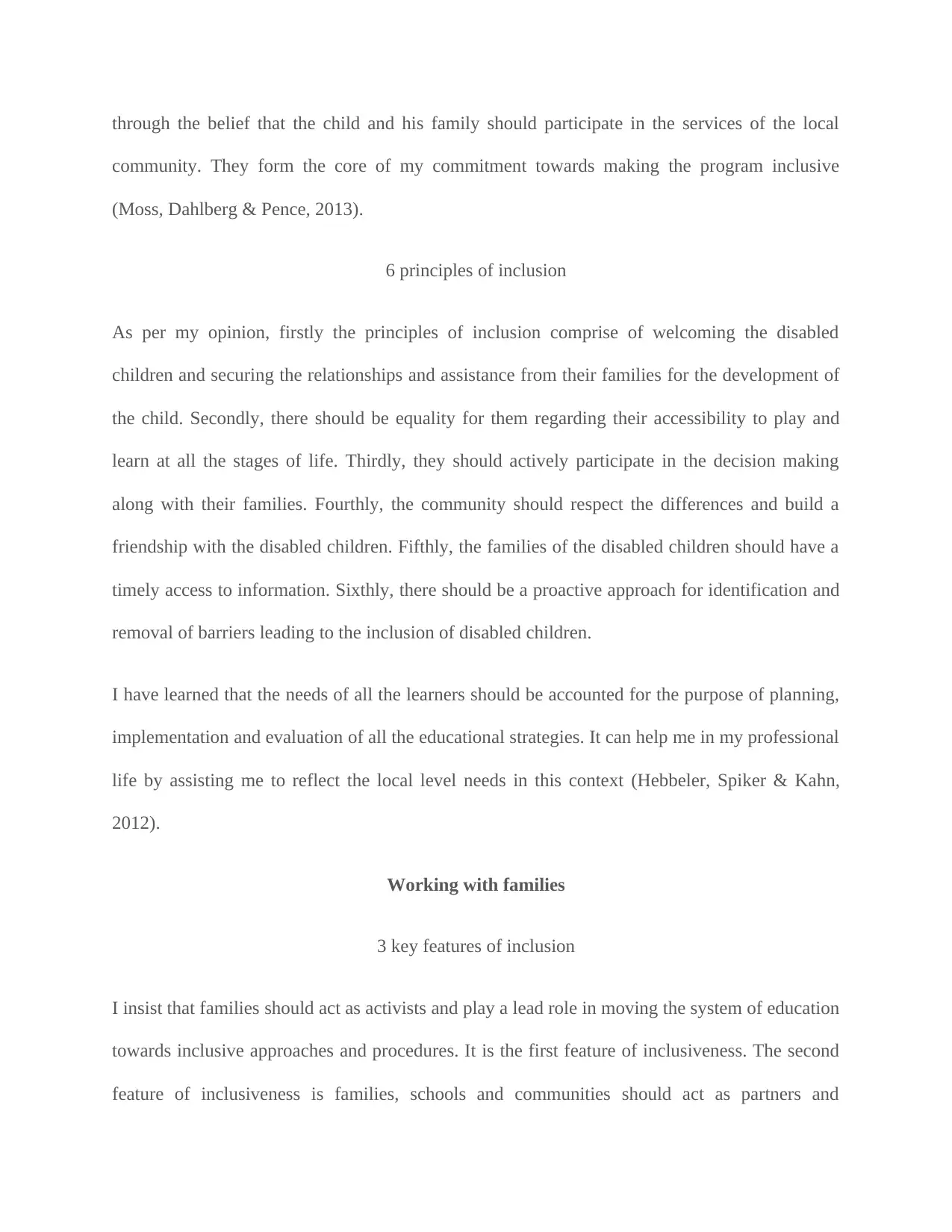
through the belief that the child and his family should participate in the services of the local
community. They form the core of my commitment towards making the program inclusive
(Moss, Dahlberg & Pence, 2013).
6 principles of inclusion
As per my opinion, firstly the principles of inclusion comprise of welcoming the disabled
children and securing the relationships and assistance from their families for the development of
the child. Secondly, there should be equality for them regarding their accessibility to play and
learn at all the stages of life. Thirdly, they should actively participate in the decision making
along with their families. Fourthly, the community should respect the differences and build a
friendship with the disabled children. Fifthly, the families of the disabled children should have a
timely access to information. Sixthly, there should be a proactive approach for identification and
removal of barriers leading to the inclusion of disabled children.
I have learned that the needs of all the learners should be accounted for the purpose of planning,
implementation and evaluation of all the educational strategies. It can help me in my professional
life by assisting me to reflect the local level needs in this context (Hebbeler, Spiker & Kahn,
2012).
Working with families
3 key features of inclusion
I insist that families should act as activists and play a lead role in moving the system of education
towards inclusive approaches and procedures. It is the first feature of inclusiveness. The second
feature of inclusiveness is families, schools and communities should act as partners and
community. They form the core of my commitment towards making the program inclusive
(Moss, Dahlberg & Pence, 2013).
6 principles of inclusion
As per my opinion, firstly the principles of inclusion comprise of welcoming the disabled
children and securing the relationships and assistance from their families for the development of
the child. Secondly, there should be equality for them regarding their accessibility to play and
learn at all the stages of life. Thirdly, they should actively participate in the decision making
along with their families. Fourthly, the community should respect the differences and build a
friendship with the disabled children. Fifthly, the families of the disabled children should have a
timely access to information. Sixthly, there should be a proactive approach for identification and
removal of barriers leading to the inclusion of disabled children.
I have learned that the needs of all the learners should be accounted for the purpose of planning,
implementation and evaluation of all the educational strategies. It can help me in my professional
life by assisting me to reflect the local level needs in this context (Hebbeler, Spiker & Kahn,
2012).
Working with families
3 key features of inclusion
I insist that families should act as activists and play a lead role in moving the system of education
towards inclusive approaches and procedures. It is the first feature of inclusiveness. The second
feature of inclusiveness is families, schools and communities should act as partners and
Paraphrase This Document
Need a fresh take? Get an instant paraphrase of this document with our AI Paraphraser
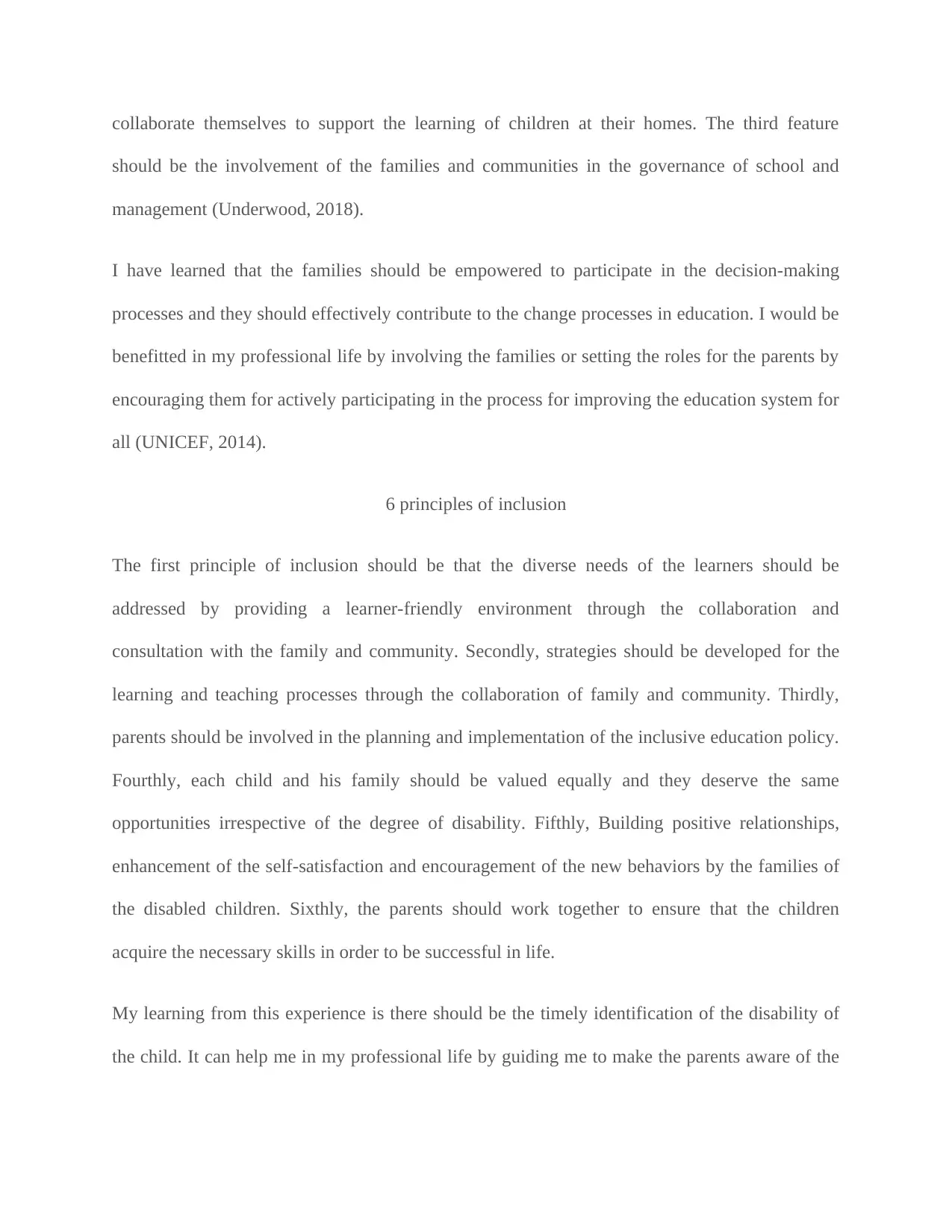
collaborate themselves to support the learning of children at their homes. The third feature
should be the involvement of the families and communities in the governance of school and
management (Underwood, 2018).
I have learned that the families should be empowered to participate in the decision-making
processes and they should effectively contribute to the change processes in education. I would be
benefitted in my professional life by involving the families or setting the roles for the parents by
encouraging them for actively participating in the process for improving the education system for
all (UNICEF, 2014).
6 principles of inclusion
The first principle of inclusion should be that the diverse needs of the learners should be
addressed by providing a learner-friendly environment through the collaboration and
consultation with the family and community. Secondly, strategies should be developed for the
learning and teaching processes through the collaboration of family and community. Thirdly,
parents should be involved in the planning and implementation of the inclusive education policy.
Fourthly, each child and his family should be valued equally and they deserve the same
opportunities irrespective of the degree of disability. Fifthly, Building positive relationships,
enhancement of the self-satisfaction and encouragement of the new behaviors by the families of
the disabled children. Sixthly, the parents should work together to ensure that the children
acquire the necessary skills in order to be successful in life.
My learning from this experience is there should be the timely identification of the disability of
the child. It can help me in my professional life by guiding me to make the parents aware of the
should be the involvement of the families and communities in the governance of school and
management (Underwood, 2018).
I have learned that the families should be empowered to participate in the decision-making
processes and they should effectively contribute to the change processes in education. I would be
benefitted in my professional life by involving the families or setting the roles for the parents by
encouraging them for actively participating in the process for improving the education system for
all (UNICEF, 2014).
6 principles of inclusion
The first principle of inclusion should be that the diverse needs of the learners should be
addressed by providing a learner-friendly environment through the collaboration and
consultation with the family and community. Secondly, strategies should be developed for the
learning and teaching processes through the collaboration of family and community. Thirdly,
parents should be involved in the planning and implementation of the inclusive education policy.
Fourthly, each child and his family should be valued equally and they deserve the same
opportunities irrespective of the degree of disability. Fifthly, Building positive relationships,
enhancement of the self-satisfaction and encouragement of the new behaviors by the families of
the disabled children. Sixthly, the parents should work together to ensure that the children
acquire the necessary skills in order to be successful in life.
My learning from this experience is there should be the timely identification of the disability of
the child. It can help me in my professional life by guiding me to make the parents aware of the
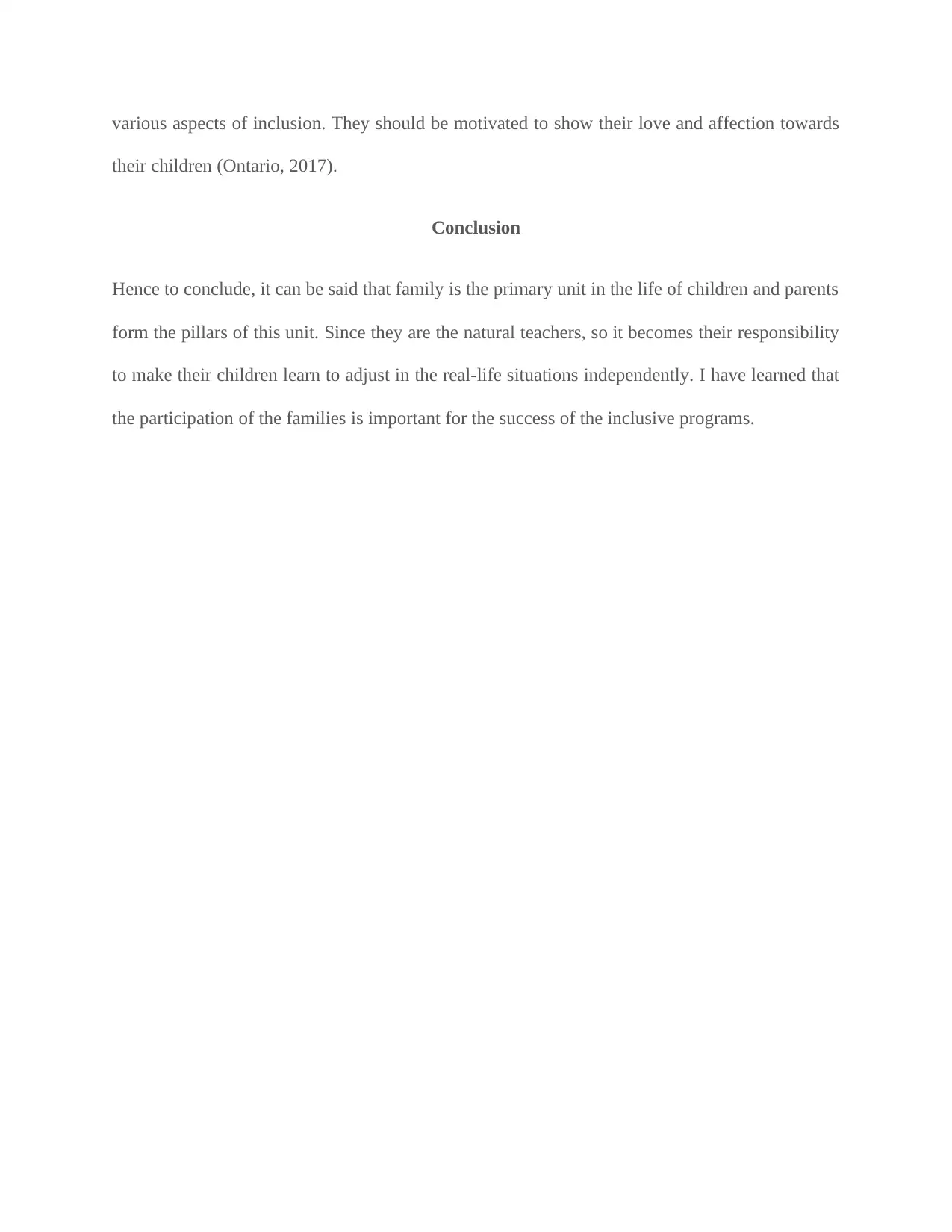
various aspects of inclusion. They should be motivated to show their love and affection towards
their children (Ontario, 2017).
Conclusion
Hence to conclude, it can be said that family is the primary unit in the life of children and parents
form the pillars of this unit. Since they are the natural teachers, so it becomes their responsibility
to make their children learn to adjust in the real-life situations independently. I have learned that
the participation of the families is important for the success of the inclusive programs.
their children (Ontario, 2017).
Conclusion
Hence to conclude, it can be said that family is the primary unit in the life of children and parents
form the pillars of this unit. Since they are the natural teachers, so it becomes their responsibility
to make their children learn to adjust in the real-life situations independently. I have learned that
the participation of the families is important for the success of the inclusive programs.
⊘ This is a preview!⊘
Do you want full access?
Subscribe today to unlock all pages.

Trusted by 1+ million students worldwide
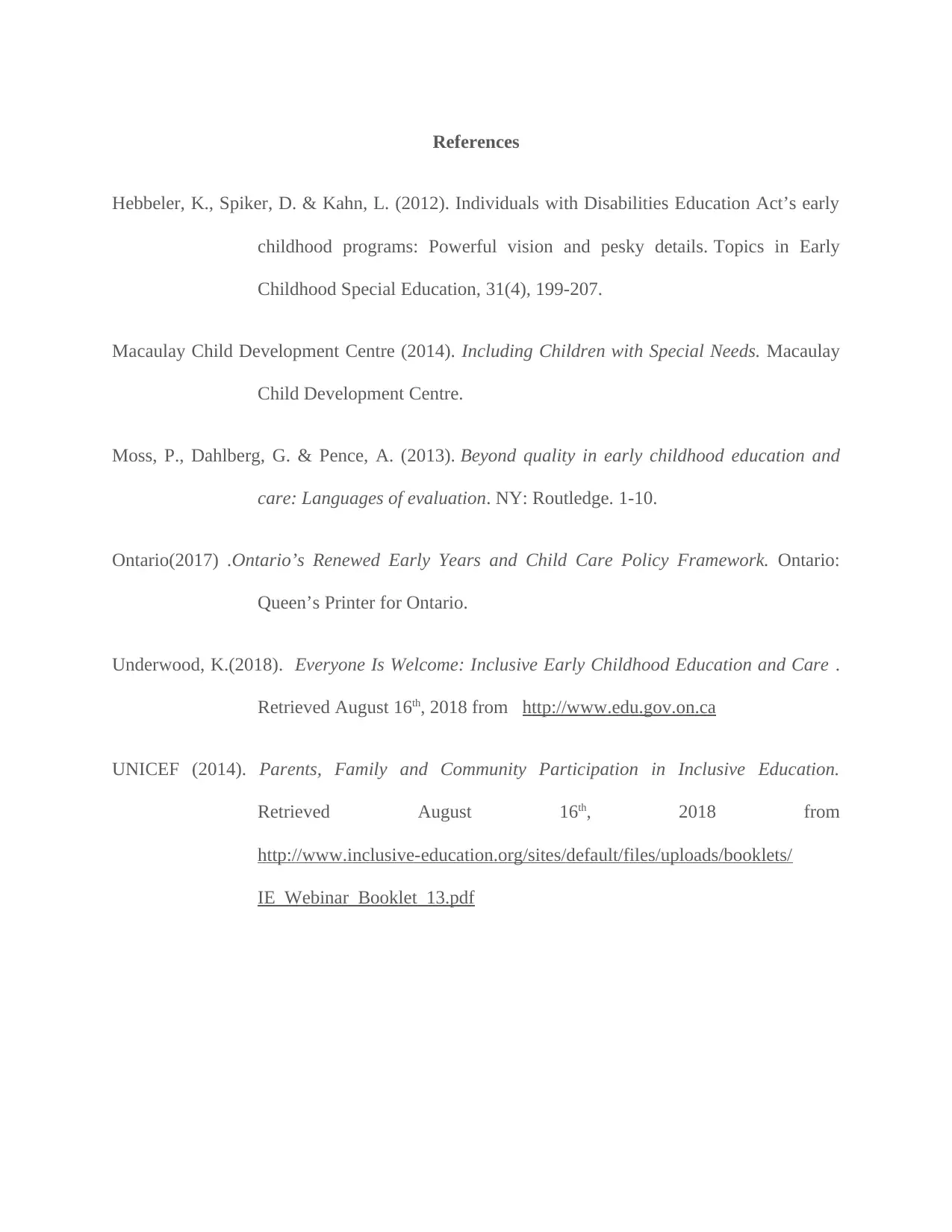
References
Hebbeler, K., Spiker, D. & Kahn, L. (2012). Individuals with Disabilities Education Act’s early
childhood programs: Powerful vision and pesky details. Topics in Early
Childhood Special Education, 31(4), 199-207.
Macaulay Child Development Centre (2014). Including Children with Special Needs. Macaulay
Child Development Centre.
Moss, P., Dahlberg, G. & Pence, A. (2013). Beyond quality in early childhood education and
care: Languages of evaluation. NY: Routledge. 1-10.
Ontario(2017) .Ontario’s Renewed Early Years and Child Care Policy Framework. Ontario:
Queen’s Printer for Ontario.
Underwood, K.(2018). Everyone Is Welcome: Inclusive Early Childhood Education and Care .
Retrieved August 16th, 2018 from http://www.edu.gov.on.ca
UNICEF (2014). Parents, Family and Community Participation in Inclusive Education.
Retrieved August 16th, 2018 from
http://www.inclusive-education.org/sites/default/files/uploads/booklets/
IE_Webinar_Booklet_13.pdf
Hebbeler, K., Spiker, D. & Kahn, L. (2012). Individuals with Disabilities Education Act’s early
childhood programs: Powerful vision and pesky details. Topics in Early
Childhood Special Education, 31(4), 199-207.
Macaulay Child Development Centre (2014). Including Children with Special Needs. Macaulay
Child Development Centre.
Moss, P., Dahlberg, G. & Pence, A. (2013). Beyond quality in early childhood education and
care: Languages of evaluation. NY: Routledge. 1-10.
Ontario(2017) .Ontario’s Renewed Early Years and Child Care Policy Framework. Ontario:
Queen’s Printer for Ontario.
Underwood, K.(2018). Everyone Is Welcome: Inclusive Early Childhood Education and Care .
Retrieved August 16th, 2018 from http://www.edu.gov.on.ca
UNICEF (2014). Parents, Family and Community Participation in Inclusive Education.
Retrieved August 16th, 2018 from
http://www.inclusive-education.org/sites/default/files/uploads/booklets/
IE_Webinar_Booklet_13.pdf
1 out of 7
Related Documents
Your All-in-One AI-Powered Toolkit for Academic Success.
+13062052269
info@desklib.com
Available 24*7 on WhatsApp / Email
![[object Object]](/_next/static/media/star-bottom.7253800d.svg)
Unlock your academic potential
Copyright © 2020–2025 A2Z Services. All Rights Reserved. Developed and managed by ZUCOL.





